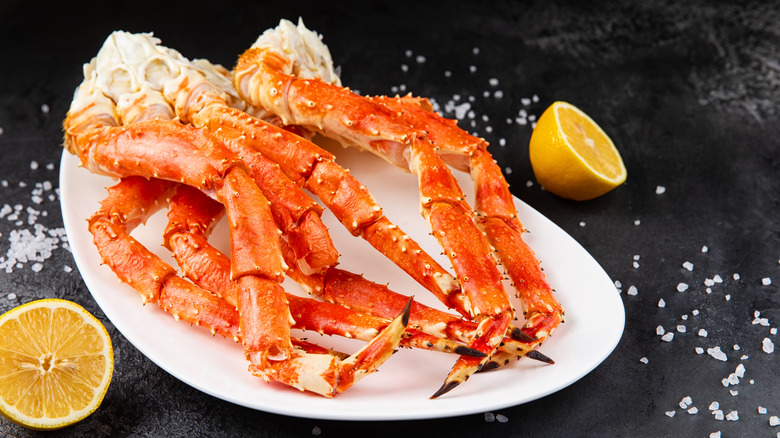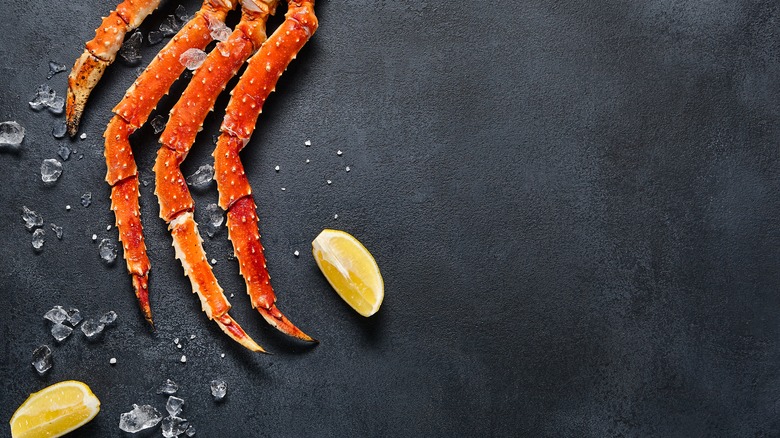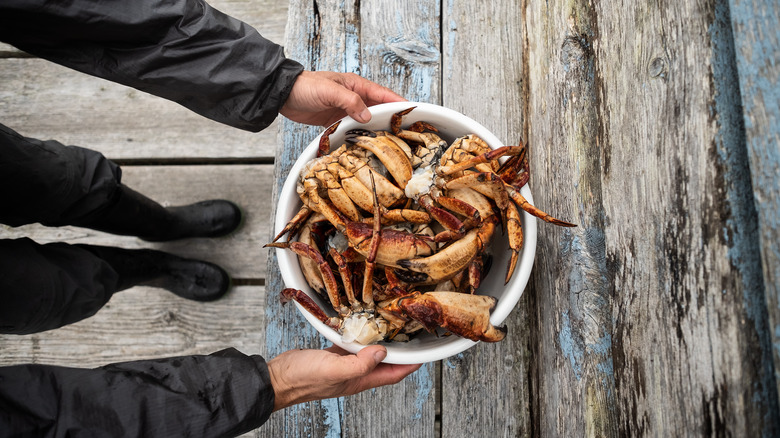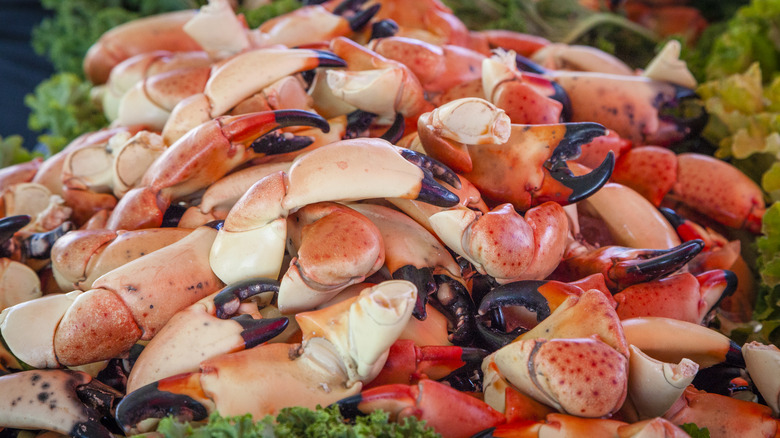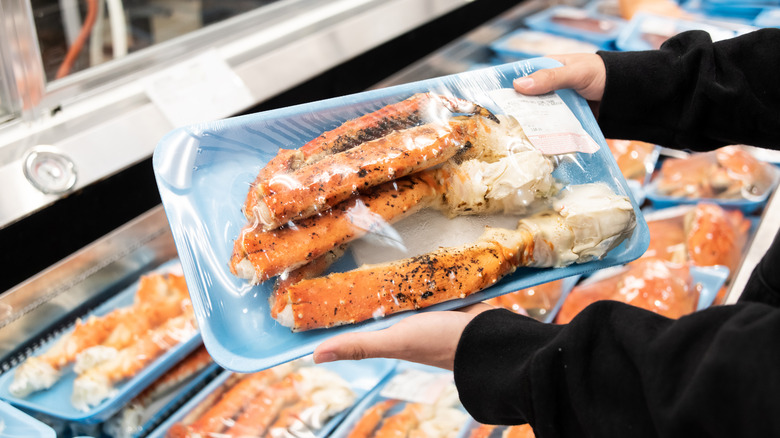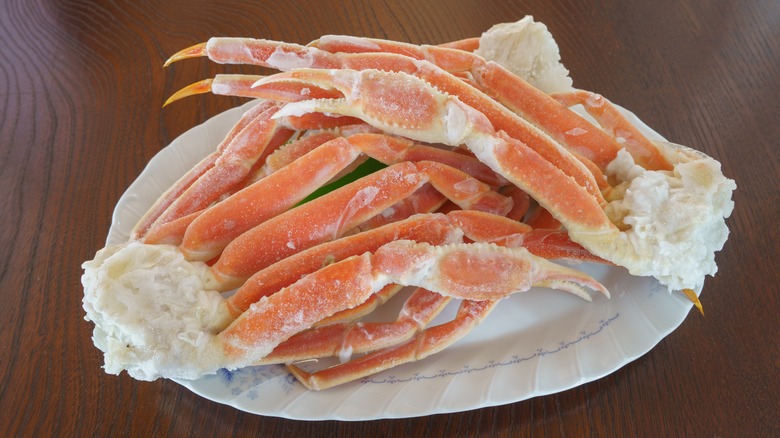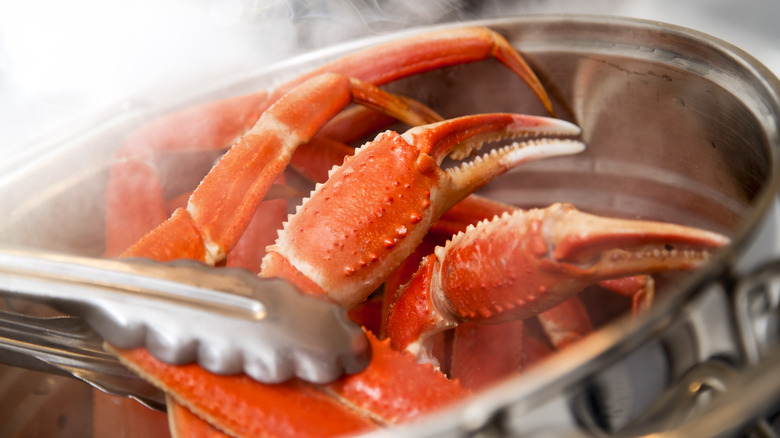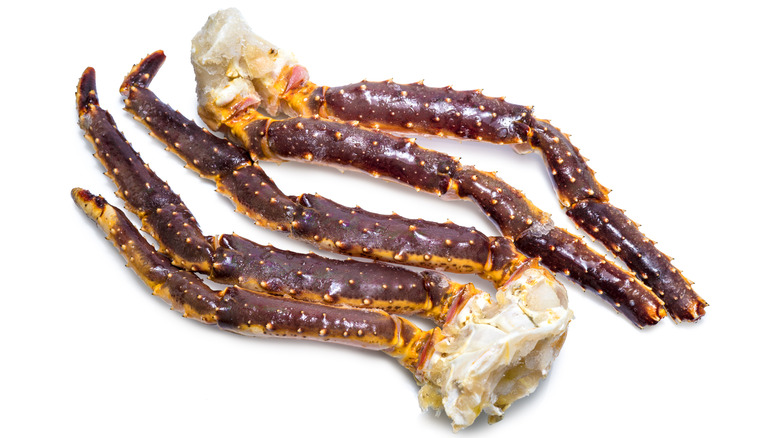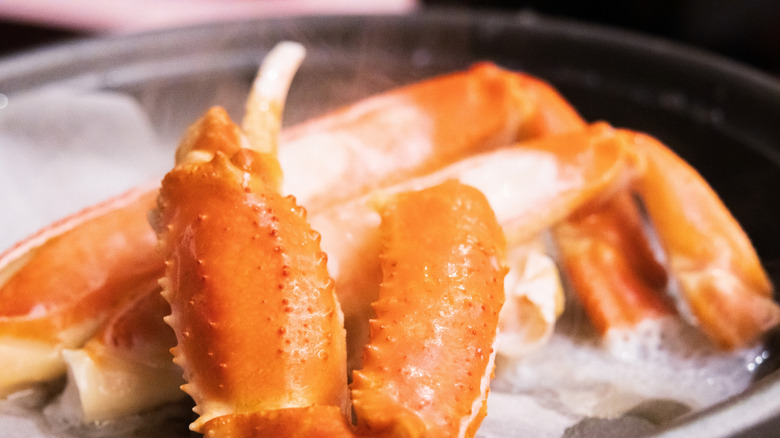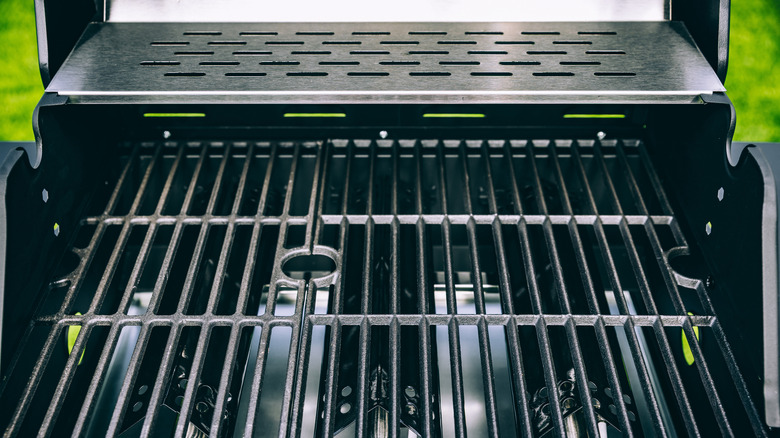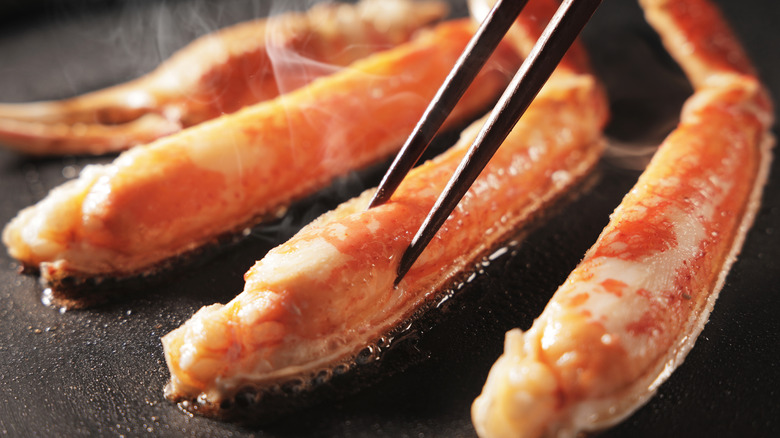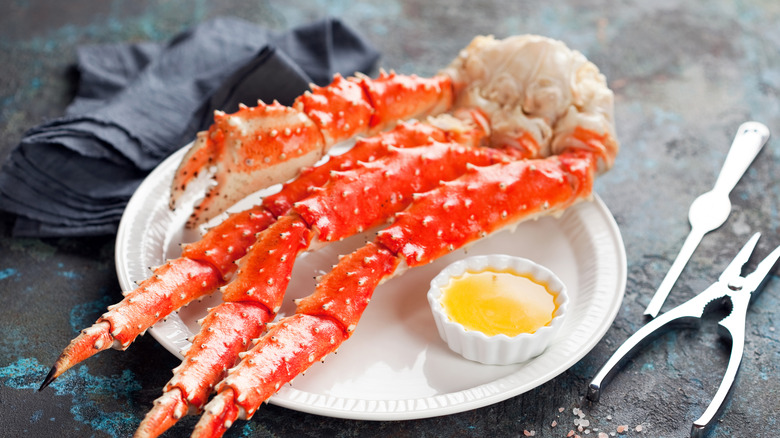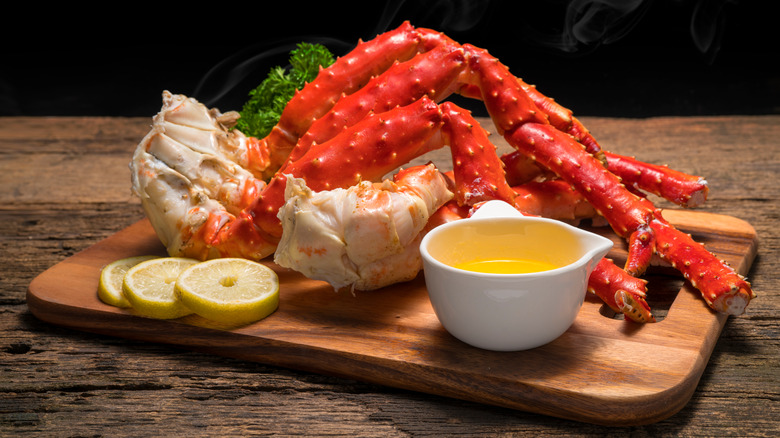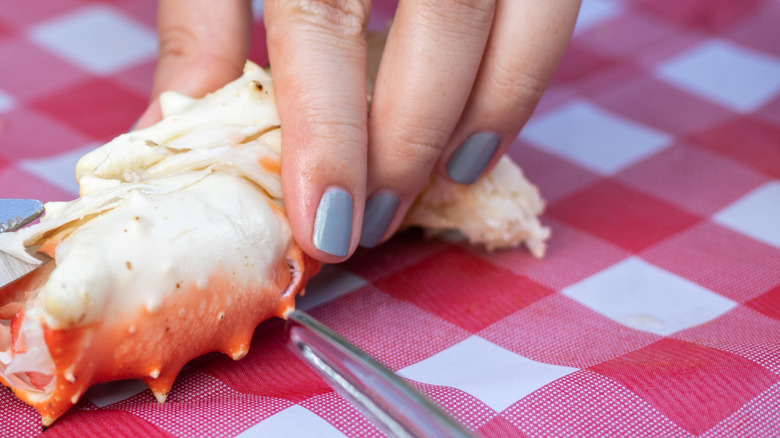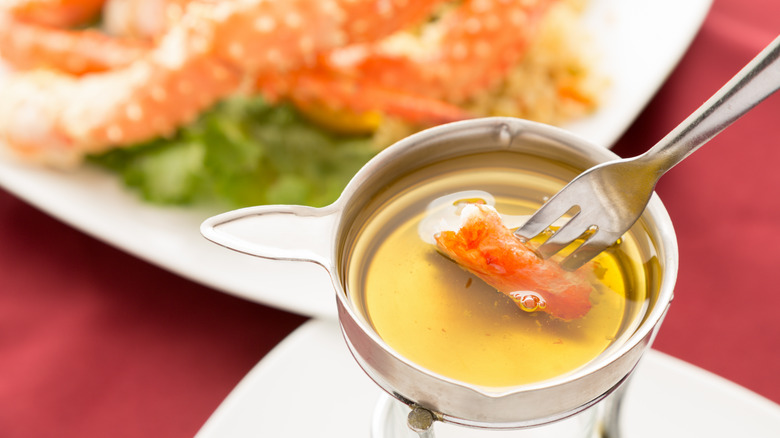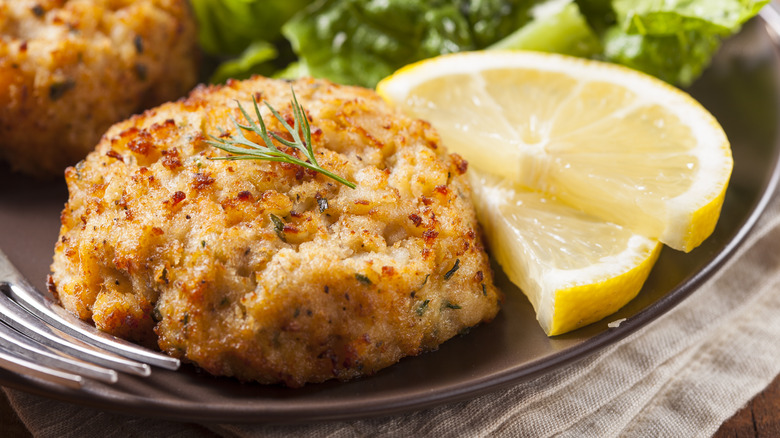Chef Warns Not To Make These Mistakes When Cooking Crab Legs
Buttery, succulent, luxurious, and expensive are just a few of the words that come to mind when thinking about crab legs. One of the most popular seafood choices in the U.S., the crab has become a staple of the American diet thanks to it being more readily available and among the healthier options compared to other crustaceans. That said, unless you plan to hit up a restaurant to eat crab legs, which can cost a pretty penny, you should learn how to make them at home, a process that can involve many hiccups if you've never done it before.
Fortunately, you have a resident expert in the Daily Meal house to help you navigate how to cook crab legs. I created numerous crab dishes in my 18-year career as a professional chef. One of the most popular themed dinners I ever made at my restaurant was a Crab Fest. For the occasion, I purchased, prepared, and cooked over 40 pounds of fresh Alaskan king crab legs, turning the luscious meat into recipes ranging from cakes and bisque to quesadillas and an Oscar sauce to spoon over a perfectly cooked medium-rare steak. The occasion was an exercise in excess that had every one of my guests drooling with delight. I am here to convey some of the best tips and tricks I employed to help you avoid the most common mistakes everyone makes when cooking crab legs.
Mistake: Buying poor-quality crab legs
The best advice I can give for buying quality crab legs is to purchase them from a reputable seafood purveyor. If you do not have a dedicated seafood market nearby or a grocery store that you know has a high turnover rate for inventory and is sourcing its product regularly, this is not an ingredient to pick up just because you happen to see it on sale. If you are unsure, it may behoove you to purchase crab legs from an online purveyor accustomed to shipping seafood safely and efficiently.
You can purchase crab legs fresh or frozen. To determine the quality of fresh crab legs, look for ones that are vibrant-hued, glossy, have a dense texture, feel heavier than they appear, and have a sweet, oceany aroma, not a chemically ammoniated one. Frozen legs should not have any evidence of freezer burn or damage to the packaging. While size may be a consideration, as smaller legs may be more luscious than bigger ones, this is contingent on the species. Lastly, if you can obtain crab in season, this is advisable.
Mistake: Not checking for sustainable crab leg options
According to the Marine Stewardship Council, while sustainable fish species do not exist, sustainable populations do. If this sounds confusing, it need not be. The MSC Fisheries Standard is a certification that relies on a collaboration between experts, the fishing trade, and conservation organizations. Certification focuses on three core principles to determine sustainability: population health, preservation of the wellness of the ecosystem and other species (e.g. reducing bycatch), and adherence to evolving environmental protection legislation. Those fisheries meeting all three criteria will obtain a blue MSC label to display on their seafood packaging.
Another good resource for determining the sustainability of a particular fish population is The Monterey Bay Aquarium Seafood Watch program, which divides seafood into Best Choice, Good Alternative, and Avoid categories. If you are unsure or do not see a label on the crab you are purchasing, ask the purveyor for detailed information on where the product was caught and how it was farmed. If you are unsure, skip it.
Mistake: Not considering the different kinds of crab
While only a few types of crab are commonly found in markets and safe for regular consumption, these crustaceans are some of the most prolific and resilient on the planet, with thousands of species inhabiting waterways across the globe. Each edible type differs in dimensions, flavor, and consistency, ranging from firm to fall-apart tender, depending on where the creature resided throughout its lifespan.
King, snow, and stone crabs are the most common species found when hunting for legs to consume. The largest are king crabs, generally sourced from the cold Alaskan waters. They are sweet and firm, resembling the meat of a lobster. Snow crabs are also a cold-water species, though they tend to be smaller than king crabs. They, too, have firm, fibrous flesh but a slightly more oceany taste. They are often preferred for their less spiky and easy-to-access shells, which can be broken apart by hand without special tools. Stone crabs hail from the warm waters of Florida. They are also easy to crack into, possessing a flesh that is far more tender, flaky, and extremely sweet. They typically cost more and are often preferred because they are a more sustainable option.
Mistake: Storing crab legs for too long
Now that you have taken the time to locate a reputable purveyor to obtain quality crab legs and have spent a small fortune on them, you should be mindful of getting these beauties home quickly and storing them safely. How you store crab legs matters regardless of whether you purchase fresh or cooked ones. They should be carefully encased in cling wrap or foil before being placed in a nonreactive, airtight container or freezer bag. From there, you can refrigerate or freeze them, depending on how rapidly you plan to consume them.
When refrigerated, fresh crab will only last about three days, while cooked legs can be held longer, around seven days. If you plan to freeze your crab legs, they can be stored for around six months, assuming there is no evidence of thawing and refreezing. Always store crab legs in the coldest part of the refrigerator or freezer, away from the door. If you notice that the crab legs have begun to smell ammoniated, look slimy or discolored, or are otherwise compromised, discard them.
Mistake: Forgetting to thaw the crab legs
While you can cook crab legs from a frozen state, they are more challenging to work with. They cook more slowly and unevenly, and their texture tends to be less supple, even with firm-fleshed varieties. It is always best to thaw crab legs before you prepare, cook, and consume them. The key is to do so safely, which requires some forethought.
The best way to thaw crab legs is to transfer them to the refrigerator overnight. If you purchase crab legs from the store that have been vacuum-sealed, you will want to remove them from this packaging and transfer them to a clean plastic bag. I recommend against simply placing them into a nonreactive bowl and thawing them as-is, as their aroma can easily overwhelm everything else in your refrigerator.
You can thaw them relatively quickly, within about an hour, by placing them in a clean plastic bag and submerging this bag in cold water in a clean bowl if you forget to thaw your crab legs in advance. The cold water should be replaced every 20 minutes until the crab is thawed.
Mistake: Overcooking the crab legs
Like most meat, and perhaps even more so, crab legs can become inedible when overcooked. Their flesh develops a dense, chewy texture that is more like a rubber ball than a delicacy you should consume. For this reason, regardless of whether you purchase fresh or cooked crab legs or how you choose to cook them, you should always be mindful of not overcooking them.
The first key is identifying if you have obtained fresh or cooked crab. You should be aware of this before you leave the store. If it is not clearly labeled, ask your purveyor. This will influence how you store the crab for safekeeping, as well as its ultimate flavor. It may also impact how you choose to cook it and for how long.
The perfectly cooked crab should have buttery or white flesh and a salmon or crimson-hued shell rather than a green or brown one. It will also be tender when poked with a paring knife. An overcooked crab will resist the knife and be dehydrated rather than moist and juicy.
Mistake: Undercooking the crab legs
While eating overcooked crab legs can be an unpleasant experience, consuming undercooked ones can be downright dangerous. Raw or undercooked crab can harbor pathogenic and potentially lethal bacteria and parasites, including Vibrio cholerae and Paragonimus westermani, also known as the lung fluke. The flesh can also have a squishy texture and be hard to remove from the shell. For this reason, you should always cook fresh crab thoroughly and, in my opinion, reheat cooked crab before consuming it, as you cannot guarantee that the crab was safely prepared and stored at a proper temperature from harvest to purveyor to your dining room table.
An undercooked crab is easily identified by its greenish or brownish shell. Its flesh is more challenging to assess, as it should be white, though perhaps slightly less opaque, when undercooked. If the flesh is brownish, it may be unsafe to eat. Fully cooked crab legs will float, and a paring knife inserted into the flesh will enter easily without resistance.
Mistake: Not steaming crab legs
While the classic low-country crab or seafood boil is legendary, it turns out that boiling crab legs is perhaps not the best way to prepare them for maximum flavor and texture. For one, it's far easier to overcook crab legs when you boil them. Additionally, they tend to lose some flavor in the boiling water while becoming waterlogged, making the meat soggy rather than tender. A far better option for cooking or reheating crab legs is to steam them.
When steaming crab legs, use a steamer basket big enough to hold them so a tight-fitting lid can be placed over the pot, or the steam will escape. If you cannot get a tight seal, consider wrapping the edge of the lid with foil to trap the steam, but take care not to burn yourself when you remove it. Depending on the size and whether the crab was fresh or cooked, they may take 5 to 10 minutes to steam to perfection. You will know the legs are done when they are bright red and you begin to smell the sweet crab meat.
Mistake: Skipping the grill for crab legs
We all know that the grill can transform virtually any food into a smoky delight. This is doubly so for delicate, sweet crab legs. The flavor conferred by either a gas or charcoal grill is hard to beat, and while it may seem intimidating to cook these expensive crustacean limbs on the grill, it really couldn't be easier. This technique works best with already cooked and thawed crab legs. I recommend patting them dry and generously coating them in oil before popping them onto your preheated grill.
Though you can use higher heat to cook crab legs, a slightly lower temperature, around 300 degrees Fahrenheit, is easier to control, minimizing the chance of overcooking them. The crab legs should take roughly five minutes per side to be done to perfection. You will know they are ready when you smell the sweet crab meat, the flesh is moist and juicy, and a light char kisses the shell.
Mistake: Ignoring the oven for reheating crab legs
The oven may be your best bet when reheating many pre-cooked crab legs at once. When I was making my crab-themed menu and needed to prepare dozens of pounds of legs, this was the method I used. It is relatively easy to execute, quick, and efficient. The biggest potential issue with this method is overcooking the crab and drying out the flesh.
This method works best with thawed crab legs. Frozen ones will bake unevenly, resulting in spots that are dry and others that are undercooked. Preheat your oven to 350 degrees Fahrenheit and place the crab legs onto a baking sheet in a single layer. You will want to drizzle them with olive oil and season with whatever spices you prefer. The key is to place some water onto the bottom of the baking sheet and cover the crab legs in foil so that you can create a steam bath that will help keep them juicy while they cook. This method typically takes around 10 minutes to execute.
Mistake: Only thinking inside the box when reheating crab legs
Sometimes, thinking outside the box is the best route when cooking something. This is no less true when it comes to crab legs. Many methods have utility when cooking and reheating crab legs, and each confers a distinct flavor, texture, and quality. The air fryer can save you time and produce supremely tender crab legs by circulating air around them. If you have the time, you will want to go low and slow and use your smoker to infuse the crab legs with extra flavor from the hardwood of your choice.
Though the microwave is not my preferred method for cooking crab legs, it can be quick if you're pressed for time. The key is to be careful not to overcook them. I always recommend shortening the cooking time by half when you begin. You can cook crab legs longer, but you cannot uncook them. Lastly, if you have an immersion circulator, sous vide crab legs can turn out uniformly moist and delicious without becoming waterlogged or losing flavor.
Mistake: Seasoning crab legs incorrectly
Though crab legs have inherently sweet, succulent flesh that does not require too much by way of additional seasoning, at the very least, they can benefit from some kosher salt to amplify their inherent brininess, regardless of cooking method. That said, don't stop there. If you plan to boil or steam crab legs, consider bolstering the cooking fluid with aromatic liquids, including citrus juice, a dry white wine, seafood stock, or broth. You can also create a bouquet garni using fresh or dried herbs, peppercorns, bay leaves, and whole, dried spices.
When baking, grilling, smoking, or air-frying crab legs, you can apply ground spices and dried herbs directly to the crab legs to infuse them with flavor. You will want to ensure they are coated with oil first so the seasonings have something to adhere to. Then, apply your spices. Blends like Old Bay or any fish fry seasoning are convenient but can be excessively salty. Consider creating your own blend using ground paprika, celery seed, mustard powder, bay leaves, ginger, cardamom, cloves, and cinnamon for a bright, fresh, yet complex flavor.
Mistake: Using the wrong tools for eating crab legs
While knowing how to purchase, store, and prepare your crab legs is necessary, being able to consume them efficiently and gracefully is something of an art form. I don't know about you, but a few foods are more frustrating and daunting to break into than crab. Any food that requires complicated gadgets, like mallets and crackers, to access and a full-body coverall to protect your clothing from the meat and juices spraying all over is arguably something that may dissuade some from ever endeavoring to consume it, which is a darn shame since crab is so delicious.
Employing your handy kitchen shears is the solution to properly and effectively cleaning crab legs. Once you have cooked your crab legs, you want to break the shell with your hands. With some varieties of crab, this will be enough to liberate the meat from the shell without further effort. For others, using the kitchen shears to cut along the length of the shell will help to vacate that luscious meat.
Mistake: Neglecting to clarify butter
Now that you have successfully removed that delectable, succulent crab meat from its shell, you can eat it as-is, but if you want to enhance its inherent buttery flavor, consider clarifying some butter to dip it in. You could use a compound butter or other dipping sauce, but these tend to be quite thick and heavy, with mayonnaise bases that can mask the delicate flavor of the crab. Clarifying butter removes the milk solids and water from the butterfat, leaving behind a smooth, glossy product that has a nutty flavor and is infinitely dippable.
The key is knowing how to clarify butter correctly so it doesn't burn before the milk solids and water separate from the butterfat. This should always be done slowly and gently over low heat, without mixing the butter. You will also want to use good-quality, unsalted butter. High-fat European butter varieties are always best for this process, like Kerrygold, Plugra, or Finlandia.
Mistake: Throwing away leftovers
If your household is anything like mine, leftover crab meat is unheard of. That said, should you have a few morsels of crab left behind, you will want to store it safely in an airtight container for use in other recipes throughout the next couple of days. Some of my favorite ways to use leftover crab meat are to form them into delectable cakes served with a remoulade sauce or to turn them into a velvety seafood bisque. Other uses include salads, quesadillas, omelets, or as a topping for a classic eggs Benedict.
Adding crab to your mashed potatoes is an unusual application that will knock your socks off. The buttery, fluffy, creamy potatoes perfectly accompany homemade crab salad. If you want to go all out, pop some crab fat into the potatoes. This purée, made from the tomalley of the crab, is beautifully briny and rich, amplifying the delicacy of the meat.
